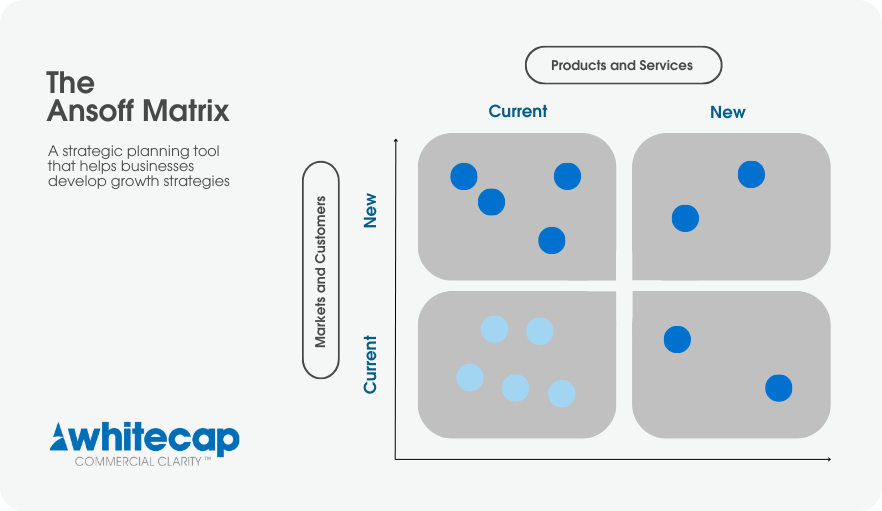In these times of consolidation however, the business still has the opportunity to make decisions about investment and resource allocation, and these decisions, we argue, lead to better outcomes when informed by a thorough understanding of market dynamics to complement internal performance metrics.
Most businesses want to grow…
As part of our advisory work, we work with many businesses that have clear growth ambitions. For those where these ambitions have recently crystallised, they are now considering their options for the delivery of that growth.
To be in a position where these considerations become a commercial imperative that merits dedicating time and resources to resolve usually means a few conditions need to be met:
- The leadership team is serious about its growth ambition and committed to it.
- Macro-factors, external to the business are supportive of the stated ambitions or, at least, don’t present strong headwinds.
- There is a ‘war chest’ of some description, either built from retained earnings, fresh investment or a new resource waiting to be deployed.
- The headroom for continued growth by doing the same thing as today is perceived as running out.
- There’s a desire to test current thinking or understanding, often aided by bringing in a fresh pair of eyes, and some independent rigour to the process.
…it’s not always the right time to chase that growth, especially in new markets…
But what if some of those conditions aren’t met, particularly when the external headwinds put the business is in a situation where growth frankly feels like a bit of a dream and survival would be quite nice, thank you.
Well, somewhat counterintuitively, a number of the same strategic responses may still apply.
Yes, there might be more of a focus on cost and efficiency initiatives in the latter scenario, but if a structured approach to future growth entails identifying and targeting markets based on their relative attractiveness and fit to the firm’s competitive strengths, why would this assessment be any less valuable when instead prioritising the consolidation of previous growth and driving for performance optimisation?
…you can always find a better mix across your current markets…
The main difference between a company focused on growth and one focused on the consolidation of gains may in fact be that the former is often looking for markets and revenue streams that are additive where the latter is more usually looking to understand which of its current markets and revenue streams are optimal (i.e. that give them the best return for deployment of existing resources, or that represent the best near to mid-term market opportunity for upside).
…as long as you actually know what’s really going on in those markets!
This assessment is bound to lean to some degree on internal analysis, but as a company looking to optimise its performance you still want an informed view of which of your current markets and revenue streams represents the best bet, based on a range of factors; a number of which will be external to your organisation. Which of your current product-customer markets are the ones that have the potential to give you most near to mid-term value, and therefore which are the ones to either ring fence from any cutbacks or into which you should divert resources?
One way of depicting this is to use that familiar framework: the Ansoff Matrix (see illustration). Normally this is used to help identify and categorise different growth opportunities, but it works here if we think of all the big-ticket growth opportunities as being the dark blue dots and currently off the table. If external headwinds mean your near to mid-term options are limited to the pale blue dots (your existing revenue streams), there is still value in refreshing your understanding of how external market dynamics are likely to affect the relative attractiveness of these so that even in straitened times, you have confidence you are deploying time, people and money in the most valuable way.

If you are facing into a set of external factors that make it feel as though material growth of your businesses is a tough ask, there is still plenty you can do, based on a structured analysis of your current and adjacent market opportunities to deliver strong financial performance. Every business will have a market sweet spot. External headwinds might mean you have to pause your drive for growth, but this also gives you the opportunity to identify your sweet spot and to optimise and consolidate by design.
If you’d like to discuss this blog post or share your own perspective on the issues covered, please get in touch or comment via our social media channels on LinkedIn or X.
Established in 2012, Whitecap Consulting is a regional strategy consultancy headquartered in Leeds, with offices in Manchester, Milton Keynes, Birmingham, Bristol and Newcastle. We typically work with boards, executives and investors of predominantly mid-sized organisations with a turnover of c£10m-£300m, helping clients analyse, develop and implement growth